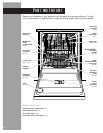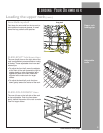
8
This section tells you how to properly load your dishwasher for the best washing and
rinsing results.
Preparing to load the dishwasher
Loading Your Dishwasher
• Make sure pot lids and handles, pizza
pans, cookie sheets, etc., do not interfere
with the spray arm rotation.
• Run a Rinse Only cycle to keep dishes
moist if you do not plan to wash them soon.
Foods like eggs, rice, pasta, spinach, and
cooked cereals can be hard to remove if
they are left to dry.
• Scrape leftover food, bones, toothpicks,
and other hard items from dishes. It is not
necessary to rinse dishes before putting
them into the dishwasher.
• Load dishes so soiled surfaces face the
spray (down or inward). It is important for
the water spray to reach all soiled surfaces.
• Take care when loading heavy pots or pans
into the dishwasher. They can dent the
stainless steel interior of the door if they are
dropped or bumped.
The upper rack is designed for cups,
glasses, and other small items.
• Load cups and glasses in the upper rack
only, in the rows between the prongs.
Placing them over the prongs can cause
them to chip or break.
• China, crystal, and other delicate items
must not touch each other during dish-
washer operation. Damage can occur.
• Place items so open ends face down for
best cleaning and draining.
• Load plastic items securely in the upper
rack only. Wash only plastic items marked
“dishwasher safe.”
• Secure lightweight items so they don’t
overturn during washing. Wedge light-
weight items against one another or
overlap them with heavier dishes. (See
“Sure-Hold clips” later in this section.)
• Load bowls in the center section for
best stability.
• Racks with teal-colored tips can be
adjusted for different loads.
Loading the upper rack
Cup and glass load
Mixed load
Upper rack
loading tips
Save time
and energy


















